Far Out Planets
About Extra Solar Planets
Are we alone in the universe? To begin to answer this question, we could first ask if Earth is unique in the universe. And to begin to answer that, we could look for solar systems around other stars. In the mid-1990s, astronomers found them.
It wasn’t easy. An extrasolar planet cannot be seen directly in a telescope, because the reflected light from the planet would be overwhelmed by the glare of the light produced by the star. Since such a planet could not be observed directly, astronomers sought a way to infer the planet’s existence through its gravitational pull on the star.
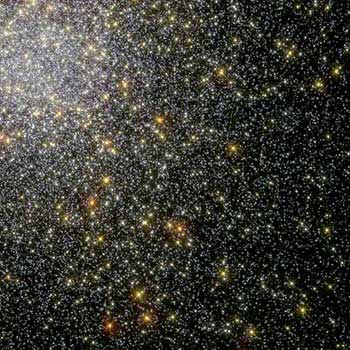
Astronomers search for extrasolar planets with the Hubble Space Telescope by looking for planetary "shadows" passing in front of stars. No large, Jupiter-like planets were detected in this "swarm" of 35 000 stars. Image courtesy of Hubble Space Telescope (STScI and NASA)
Imagine you are holding on to another person and you both are turning. If you both have the same mass, you both turn about a point halfway between the two of you. Now suppose you are turning and holding onto a small child. The child moves in a large circle and you move in a small one. You move in response to the force the child is exerting on you, the equal and opposite reaction force.
With gravity, it works in the same way. Imagine a double-star system, with both stars of equal mass. They orbit each other. The drawing shows two such stars in a circular orbit, each moving in a circle about the center. Now imagine a star orbited by a Jupiter-sized planet, with about 1/1000 the mass of the star. In this case, the star moves in a small orbit, whose center is well inside the star.
Suppose we look at a star that has a planet whose orbit is edge-on, as shown in the diagram. We cannot see the planet itself. What we can observe is the slight motion of the star as described in the paragraph above, which we see as a slight side-to-side wobble.
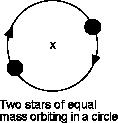
Two stars of equal mass in a circular orbit around each other
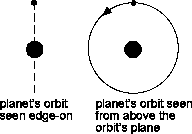
A planet’s orbit (straight line) around a star; the orbit is edge-on to our line-of-sight to the star.

The arrow shows the wavelength of the light.
When the star is moving towards or away from us, its light will be Doppler-shifted, in the same way that the sound of a siren or of a race car’s motor changes pitch as it passes an observer, as shown in the diagram. This Doppler shift changes the wavelength of the star’s spectral absorption lines, as seen from Earth, in proportion to the movement towards or away from Earth. If the orbit of the planet is edge-on, this orientation produces the greatest Doppler shift. The size of the shift enables astronomers to find the velocity of the star in the direction towards or away from Earth.
Astronomers compare the shifting absorption lines from the star with fixed emission lines from a laboratory light source. The shift is extremely small, only about one part in 100 million. Analysis of these shifts yields much information, including the period of the motion, the masses of star and planet, and the shape of the orbit.
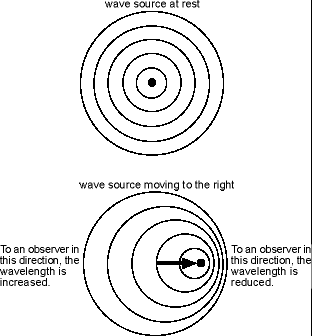
The Doppler effect: The black dot is the source of the waves, which is at rest in the drawing on the left and moving to the right in the drawing on the right. The circles are wavefronts. For example, each circle could represent a wave crest. If the source moves towards the observer, the wavefronts pile up, reducing the observed wavelength. If the source moves away from the observer, the wavefronts spread out, increasing the observed wavelength.
Research
The first observation of an extrasolar planet came in 1995, in a study of a star in the constellation Pegasus. Analysis of the size and periodicity of the star’s wobble revealed a planet of about Jupiter’s mass, orbiting eight times closer than Mercury does to the sun.
After this initial breakthrough, more discoveries came thick and fast. The planets were very large—almost larger than Jupiter—and close to their suns, some much closer than Mercury is to the sun. One system was found to have three planets, with masses ranging from .73 to 4.4 times the mass of Jupiter. Of course, not all the planets in these systems are necessarily so large or so close-in. Planets large in mass in orbits close to a star exert the biggest gravitational pull on the star, so they are the ones most likely to be found first.
The observation of a star’s wobble is an indirect way to find an extrasolar planet. An opportunity for a more direct observation arose when a system was discovered with the planet’s orbit directly in the line of sight from Earth. This meant that the planet crossed the disk of the star once in each of its years, an event called a “transit.” With each transit, the planet blocked a small part of the star’s light—a few percent—so astronomers decided to observe the intensity of the starlight before, during, and after the transit.
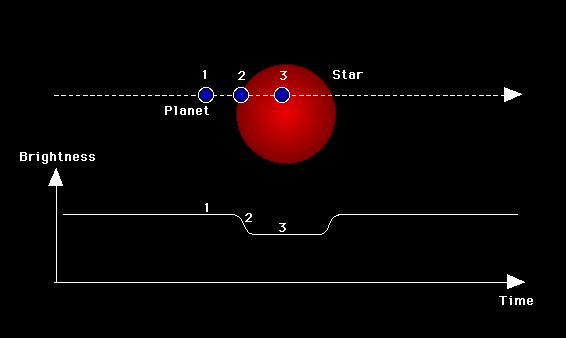
An extrasolar planet, whose orbit we observe edge-on, crosses in front of its star. From Earth, we observe the shadow of this planet as a reduction of a few percent in the intensity of the starlight. (diagram courtesy of Hans J. Deeg)
The decrease in the star’s light was indeed observed during the transit, and at just the time that had been predicted, as shown in the diagram. With this observation, the existence of the extrasolar planets was confirmed.
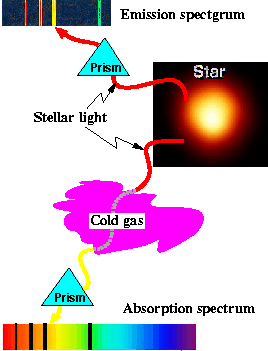
Formation of stellar absorption and emission lines. (drawing courtesy of Jose Wudka, University of California at Riverside)
This transit led to an additional discovery. The Hubble Space Telescope recorded the light from this star during transit. Analysis of the light spectrum revealed that the planet’s atmosphere contained sodium atoms, which had absorbed light from the star at particular wavelengths, corresponding to sodium’s spectral lines. (See lower half of the diagram.)
Going back to the size and distances of the extrasolar planets, the existence of large planets so close to their stars poses a significant problem for the theory of the origin of solar systems. This theory had assumed that our solar system is typical. It had stated that solar systems evolve form a rotating cloud of dust and gas, with the gas giants, like Jupiter, forming relatively far away from the star. But the observed extrasolar planets could not form so close to their stars, due to the intense heat there. According to more recent theories, large planets form far from the star and then migrate closer in. Moreover, a gas giant like Jupiter is now thought to wreak havoc in its solar system by spawning small planets and then hurling them off to distant locations.
It has been less than a decade since the first extrasolar planet was discovered, and now astronomers have found more than a hundred. The implications for our understanding of the universe, and our place in it, have been profound. Stay tuned for more exciting news.
Links
University of Arizona
NASA
Discover
Transits of Extrasolar Planets Network














